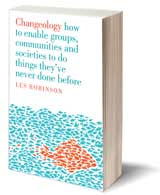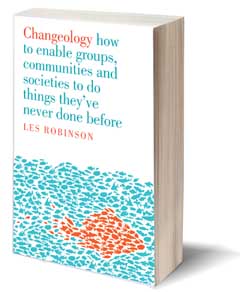|

|
Changeology, the book

A readable crash course in the thinking needed to make change happen.
Changeology brings together what practitioners, psychologists, and activists have learnt about the science and practice of influencing the behaviour of groups and communities.
"I wrote the book I wish I had when I started my career as a marketer and activist."
The result is an all-purpose approach to change which benefits from the tremendous depth of knowledge and experience of hundreds of practitioners and scholars over the years.
The model has 6 ingredients:
- Start a buzz
- Offer hope
- Create an enabling environment
- Design a sticky solution
- Expand the comfort zone
- Find the right inviter
The book illustrates each ingredient with illuminating stories and practical insights into what works. Each ingredient is followed by a practical tool that enables a project team to put the concept into action.
I hope you find it useful!
- Les
ContentsChapter 1) How to change the world When individuals act on their hopes and dreams, their lives improve. When large numbers of people act, history happens. Although new technologies, social reforms, wars and revolutions seem to be the great drivers of social change, the real "what happens" is that large numbers of people start doing things they've never done before. Chapter 2) Popular folk theories Our assumptions about the motivations of other people are frequently wrong and sometimes disastrous. The culprits are our pervasive, often unconscious, worldviews and biases. Two biases which are especially toxic for change efforts are Man is Bad Bias and Heroic Agent Bias. Method: Establish a brains trust. Chapter 3) The social immune system
Humans come with a powerful social immune system, standard in all models, that protects us against unwanted attempts to influence our behaviour. This immune system produces two potent immune responses: denial and resistance. They explain the failure of most "tell, sell or threaten" attempts to change human behaviour. Chapter 4) First, start a buzz
The historic campaign against slavery, a more recent case of mass public disobedience, and the interesting tale of Iowa corn seed point to the power of conversation to influence human behaviour. No buzz, no change. Are there rules for generating buzz? Yes. Emotionally touching stories are the essence of buzz. But not all buzz is the same. "Up buzz" leads to change, "down buzz" stifles it. Being able to encourage "up buzz" is vital for change, and hope is the key. Method: How to start a buzz. Chapter 5) Offer hope
The story of student pranks leading up to the collapse of the Milosevic regime is a chance to reflect on how change arises from thwarted hopes. When peoples' hopes are blocked, frustration and guilt are the result. This is good news for change agents, because practically everyone is frustrated, guilty or dissatisfied about something in their lives. Hope is what every successful change effort has offered its participants. We understand hot hopes and how to work with them. Method: Sketch a hopeful future.
Chapter 6) Create an enabling environment
Every behaviour is enabled or disabled by its environment. We look at six kinds of environmental tweeking - building a community, creating easiness, lowering the price, raising the price, thwarting and regulation. Method: Making a theory of change.
Chapter 7) Design a sticky solution
If you want to win people's loyalty and energy you need to satisfy their hot hopes. Chances are, satisfying at least one of three uber-wants - control, time and self-esteem - will make all the difference. But beware of Heroic Agent Bias and make sure you reality-test your ideas. Ultimately, success is about designing behaviours or products that are a good fit for peoples' lives not how cleverly you market them. Harnessing the power of reinvention is your key to spreading successful products and behaviours. Method: Testing for stickiness. Chapter 8) Expand the comfy zone
A refusal to dance the Salsa reminds us how even the simplest actions can scare the pants off people who've never done them before. There are many proven techniques for lowering peoples' fears of change, including familiarity, personal control, goals and feedback, enjoyment, discussion with peers, social proof, commitment, labelling, and incentives. These techniques are explained and illustrated with fascinating real life examples. Method: Make a theory of action. Chapter 9) Find the right inviter
Stories about Jamie Oliver, Al Gore and Richard Branson suggest how the person who issues an invitation may be more important than the invitation itself. Who are the best inviters? The evidence is that people who are passionate, similar, connected, respected and powerless are the best inviters. We look at how to find the right inviter and the elements of a persuasive invitation. Method: Creating an invitation. Chapter 10) Bringing it all together
This chapter brings these themes together into a general model of social change with six elements: hope, buzz, enabling environments, stickiness, can do, and invitation. We see how you can activate these elements the next time you try to change the world. |
"I was utterly dazzled by this book. It's by turns illuminating and inspiring. I was puzzling over fund-raising for a project I'm involved with - a school in Cambodia - and Robinson answered a whole lot of questions. What's more, his writing style makes him engaging, warm-hearted company."- organisational consultant |
ChangeologyextrasComfy Zone Diagnostic Tool
Decisions, decisions, and so much to think about! This simple tool reminds project designers about the full range of behaviour change strategies available to them and when they should be used.
Les explains the key ideas in Changeology
in this succinct interview with Rob Hopkins of the UK Transition Network.
For a taster, here's Chapter 1, including the index.
Here's a beautiful infographic that explains the entire book on a single page.
The same questions about behaviour change come up again and again. This article first appeared in The Guardian.
More tools and resources about change. |
Join the buzzJoin the Changeology LinkedIn Group to ask questions and get new change ideas. |
How to get a copyIn Australia, it's available in paperback, Kindle, eBook and iBook formats from
|
| "All great deeds and all great thoughts have a ridiculous beginning." - Albert Camus
|
| Hand made in good ol' HTML. |
